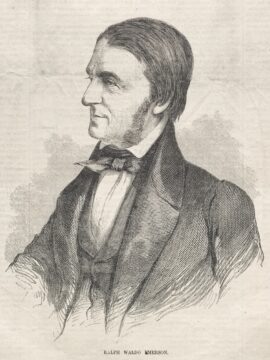Mark Jarman at The Hudson Review:
 What was Emersonian? I first saw the term used in an essay by Harold Bloom called “The New Transcendentalism” about “the visionary strain” in the American poets W. S. Merwin, John Ashbery, and A. R. Ammons. Their excellence as poets (Bloom ranked them 3, 2, 1) depended almost entirely on their Emersonianism. Bloom wrote as if everyone, including the women he omitted, knew what it meant. Now I think he meant unrestrained by conventions of a closed system, like Christianity or the Boy Scouts of America. To be Emersonian was to be true to one’s own system, whatever that might be, idealist, visionary, in any case, a poetry of the sublime and the large statement, the lingua franca of Wallace Stevens, say, but also the kitchen sink realism of William Carlos Williams, though not as wild and visionary as William Blake, or as talented. Could we say existentialist? American poets who dwelt in the Emersonian sunshine might write free verse or in song meters, like Blake. Nevertheless, Emerson’s idealism was both principle and excuse for their poetry, with Whitman and Dickinson as influential figures. Whitman’s muse was installed amid the kitchenware. Dickinson’s lived in her upstairs bedroom. Domesticated but wild, wolves in Victorian sheepskin, these Emersonians were ordained to go uncollared but prophetic, unpenned with fountain pen in hand.
What was Emersonian? I first saw the term used in an essay by Harold Bloom called “The New Transcendentalism” about “the visionary strain” in the American poets W. S. Merwin, John Ashbery, and A. R. Ammons. Their excellence as poets (Bloom ranked them 3, 2, 1) depended almost entirely on their Emersonianism. Bloom wrote as if everyone, including the women he omitted, knew what it meant. Now I think he meant unrestrained by conventions of a closed system, like Christianity or the Boy Scouts of America. To be Emersonian was to be true to one’s own system, whatever that might be, idealist, visionary, in any case, a poetry of the sublime and the large statement, the lingua franca of Wallace Stevens, say, but also the kitchen sink realism of William Carlos Williams, though not as wild and visionary as William Blake, or as talented. Could we say existentialist? American poets who dwelt in the Emersonian sunshine might write free verse or in song meters, like Blake. Nevertheless, Emerson’s idealism was both principle and excuse for their poetry, with Whitman and Dickinson as influential figures. Whitman’s muse was installed amid the kitchenware. Dickinson’s lived in her upstairs bedroom. Domesticated but wild, wolves in Victorian sheepskin, these Emersonians were ordained to go uncollared but prophetic, unpenned with fountain pen in hand.
more here.
Enjoying the content on 3QD? Help keep us going by donating now.
